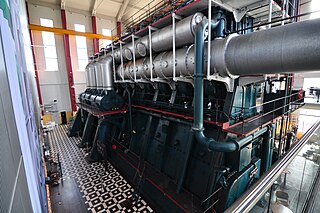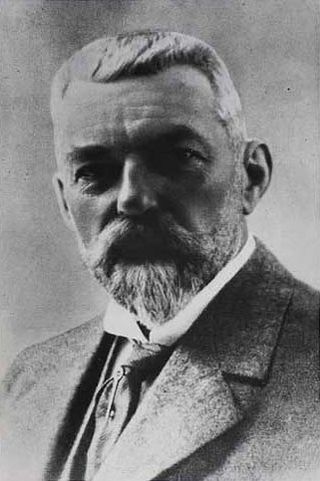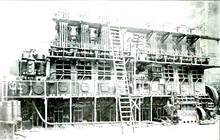
Rudkøbing is a town in Denmark, on the western coast of the island of Langeland. It is the seat of Langeland Municipality, in the Southern Denmark Region. The town is located 15 kilometres (9.3 mi) southeast of Svendborg and is connected to Siø through the Siøsund Bridge.
MAN Diesel SE was a German manufacturer of large-bore diesel engines for marine propulsion systems and power plant applications. In 2010 it was merged with MAN Turbo to form MAN Diesel & Turbo.

Selandia was the name of three ships of the Danish East Asiatic Company, the best known of which, the first MS Selandia of 1912, was the most advanced ocean-going diesel motor ship of her time.

Kongens Enghave, commonly known as Sydhavnen or the postal district of 2450 Copenhagen SV (southwest) is a district in southern Copenhagen. While its core is a largely pre-WWII former working class district, it also contains an upscale residential area along the harbour having been developed after 2000, scattered industrial areas, large parks such as Valbyparken and Sydhavnstippen, allotment gardens and parts of Vestre Kirkegård, the city's largest cemetery.

Teglholmen is a peninsula in the South Harbour of Copenhagen, Denmark, located between Sluseholmen and Enghave Brygge. The former dockland area used to house heavy industry. While some industry activities remain in the area, but since most industry left the area, starting in the 1970s, it has undergone massive redevelopment, though some industrial activities remain, most notably MAN B&W Diesel's motor development plant. Today the area houses both a considerable number of Danish and regional headquarters of multinational companies and residential developments. Teglholmen is home to Aalborg University's AAU Cph Campus as well as TV 2's activities in Copenhagen.

Johannes Frederik Johnstrup was a Danish professor, geologist and paleontologist. He was the founder of the Danish scientific periodical Meddelelser om Grønland.

Mitsui Engineering & Shipbuilding is a Japanese heavy industries company. Despite its name, it no longer builds ships and now focuses mainly on production of high-value ship equipments such as engines and automated gantry cranes.

MAN Energy Solutions SE is a German multinational company based in Augsburg that produces large-bore gas and diesel engines and also turbomachinery for marine, rail and stationary applications, as locomotive and marine propulsion systems, power plant applications, and turbochargers. The company was formed in 2010 from the merger of MAN Diesel and MAN Turbo. MAN Energy Solutions is a subsidiary of the German carmaker Volkswagen Group.

Wilders Plads is a waterfront area located just north of Wilders Kanal, a branch of Christianshavns Kanal, in the north-western corner of the Christianshavn neighbourhood of Copenhagen, Denmark. The area is bounded by Christianshavn Canal to the east and Krøyers Plads to the north.

Refshaleøen is a former industrial site in the harbor of Copenhagen, Denmark, originally on a separate island but now annexed to the larger island of Amager. For more than a hundred years, it was home to the shipyard Burmeister & Wain, which closed in 1996.

DieselHouse is an interactive exhibition on diesel technology located on the grounds of the still operating H. C. Ørsted Power Station in the South Docklands of Copenhagen, Denmark. The exhibition is centred on a gigantic decommissioned Burmeister & Wain diesel engine which was the world's largest for more than 30 years.

H. C. Ørsted Power Station is a natural gas fired combined heat and power station located at Enghave Brygge, Sydhavnen in Copenhagen, Denmark. It is owned and operated by Ørsted.

MV Aase Maersk or Aase Mærsk was a Danish 6,184 GRT oil tanker. Odense Steel Shipyard of Odense built her in 1930 for A. P. Moller of Copenhagen. She was a motor ship, powered by a Burmeister & Wain six-cylinder four-stroke single-acting marine diesel engine developing 489 NHP.

Applebyes Plads is a triangular area located between Langebro Bridge and the southernmost portion of Christianshavn Canal at the southern tip of the Christianshavn neighbourhood in Copenhagen, Denmark. The area takes its name from Peter Applebye, Christian VI's rope maker, who ran his manufactury from the site in the late 18th century, although no buildings remain from that time. The Danish Sugar Factories' building along the waterfront dates from 1912 while the rest of the grounds have undergone residential redevelopment in later years.

Andreas Bjørn was a Danish merchant, shipbuilder and ship owner.

Ivar Peter Bagger Knudsen was a Danish engineer. As the director of Burmeister & Wain (B&W), Knudsen led the development of the MS Selandia, the biggest, most advanced diesel-powered vessel of its time.
CS Pacific was a cable ship registered in Copenhagen, Denmark owned by the Great Northern Telegraph Company. The steel vessel was built in 1903 in the shipyards of Burmeister & Wain and delivered that year for the purpose of laying and repairing submarine cable in the Far East networks. Historical records of this cable ship are kept in the National Maritime Museum of Denmark. Pictorial records of the ship are available through the DieselHouse interactive initiative.

Hans Heinrich Baumgarten was a Holstein-Danish industrialist. In 1843, he founded a company which from 1846 became known as Baumgarten & Burmeister and after his retirement became Burmeister & Wain.

Diderich de Thurah (1704–1788) was a military cadet, a naval officer in the Royal Danish-Norwegian navy, shipbuilder and fabrikmester, artist and publisher.

Sophie Wilhelmine Bertha Ørsted was a Danish socialite and muse. Brought up in a literary environment in Copenhagen, she was the sister of writer Adam Oehlenschläger (1779–1850) and was married to jurist Anders Sandøe Ørsted (1778-1860). She became an inspiration for others, including the poet Jens Baggesen (1764–1826). She died of abdominal complications when she was only 35.






















